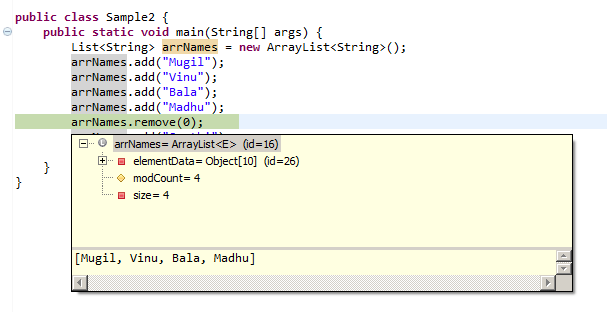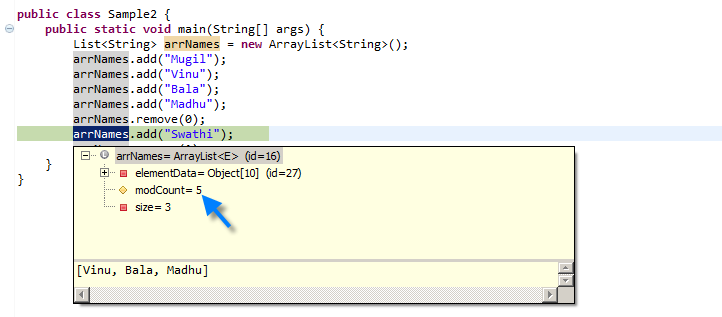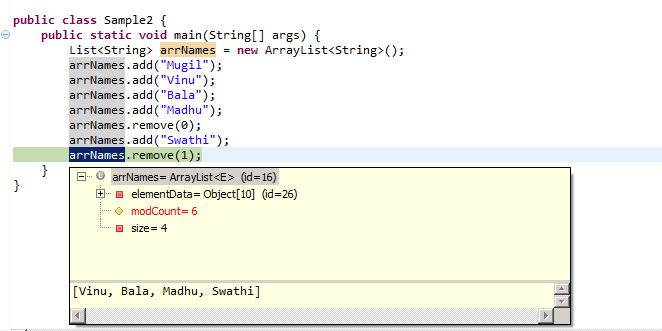- Internally an ArrayList uses an Object[] Array.
private transient Object[] elementData; - As you add items to an ArrayList, the list checks to see if the backing array has room left. If there is room, the new item is just added at the next empty space. If there is not room, a new, larger, array is created, and the old array is copied into the new one.
- When we actually create an arrayList following piece of code is executed –
this.elementData=new Object[initial capacity]; -
ArrayList can be created in two ways-
List<String> myList=new ArrayList<String>();
-
When we create an ArrayList in this way, default constructor is invoked and will internally create an array of Object with default size, which is 10.
List<String> myList=new ArrayList<String>(5);
When we create an ArrayList in this way, constructor with an integer argument is invoked and will internally create an array of Object with the size, specified in the constructor argument, which happens to be 5 in this case.
-
Inside add() method Check is made, before adding element into the array it will check what is the current size of filled elements and what is the maximum size of the array. If size of filled elements is greater than maximum size of the array then size of the array must be increased. But we know that the size of the array cannot be increased dynamically.
So what happens internally is a new Array is created with size 1.5*currentSize and the data from old Array is copied into this new Array.
Internally an ArrayList uses an Object[].
Capacity vs Size
The capacity is how many elements the list can potentially accommodate without reallocating its internal structures.
The size is the number of elements in the list
If you allocate a new array with arr = new Employee[100], the size of that array (arr.length) is going to be 100. It has 100 elements. All the elements are initially null (as this is an array of object references), but still, there are 100 elements.
If you do something like list = new ArrayList
Internally, it’s true that the ArrayList allocates enough place to put 100 items before it needs to extend its capacity, but that’s an internal implementation detail, and the list presents its content to you as “no items stored”. Only if you actually do list.add(something), you’ll have items in the list.
So although the list allocates storage in advance, the API with which it communicates with the program tells you there are no items in it. The null items in its internal array are not available to you – you cannot retrieve them or change them.
An ArrayList is just one way to represent an abstract list, and the capacity of an ArrayList is an implementation detail of how the system implements the logical list.
An ArrayList stores the elements of a list by using an actual array “under the covers.” The actual realization of the array in computer memory has a certain size when it is allocated; this size is the ArrayList’s capacity. The ArrayList emulates a variable-sized list by storing the logical length of the list in addition to the fixed-length array. Thus if you have an ArrayList with a capacity 10 which contains 4 logical elements, the ArrayList can be represented as a length and an array
(4) | e1 | e2 | e3 | e4 | __ | __ | __| __ | __ | __ |
where the (4) is the logical length of the list and ‘__’ represent data that is ignored because it is not part of the logical list. If you attempt to access the 5th element of this ArrayList, it will throw an exception because it knows that the fifth element has not been initialized. If we then append an extra element e5 to the list, the ArrayList becomes
(5) | e1 | e2 | e3 | e4 | e5 | __ | __ | __ | __ | __ |
Note that the capacity has not changed, while the logical length has, because the underlying array is still able to handle all the data in the logical list.
If you manage to add more than ten elements to this list, the ArrayList will not break. The ArrayList is an abstraction meant to be compatible with all array operations. Rather, the ArrayList changes its capacity when its logical length exceeds its original capacity. If we were to add the elements (a1, a2, …, a7) to the above list, the resulting ArrayList might look like
(12) | e1 | e2 | e3 | e4 | e5 | a1 | a2 | a3 | a4 | a5 | a6 | a7 | __ | __ | __ | __ | __ | __ | __ | __ |
with a capacity of 20.
Once you have created an ArrayList, you can ignore the capacity in all programming that follows; the logic is unaffected. However, the performance of the system under certain kinds of operations can be affected. Increasing the capacity, for instance, might well involved allocating a larger array, copying the first array into the second and then performing the operations. This can be quite slow compared to, e.g. the same operation on a linked list. Thus it is sensible to choose the capacity of an ArrayList to be bigger than, or at least comparable to, the actual number of elements expected in the real runtime environment.
Is there a Way to Create ArrayList of Fixed size in Java
List<String> fixedSizeList = Arrays.asList(new String[100]);
You cannot insert new Strings to the fixedSizeList (it already has 100 elements). You can only set its values like this:
fixedSizeList.set(7, "new value");
What would be the Output of the Following Code
List<Employee> employees = new ArrayList<>(100); int size = employes.size();
size will be 0 while the initial capacity is 100.


